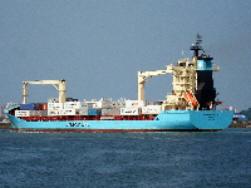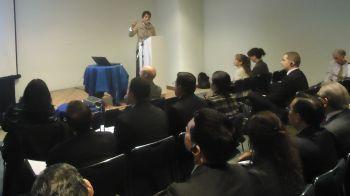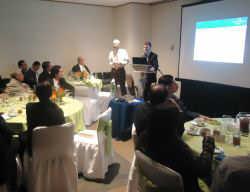Collaboration with Mexico to Reduce Emissions from Ships
 The Maersk Line ship "Roubaix."
The Maersk Line ship "Roubaix."- Learn more about Emission Control Areas (ECAs)
- Learn more about recent efforts below under the "Collaboration" tab.
- Reducing Emissions from Goods Movement via Maritime Transportation in North America
In the first phase of this project (2013-2014), Exitthe US, Mexico and Canada developed the needed analyses for Mexico’s possible ratification of MARPOL Annex VI and establishment of an ECA. The second phase (2015-2016) Exit focused on facilitating the development of a strategy for the establishment and implementation of an ECA in Mexico. In the third phase (2017-2018), ExitMexico, with help from the U.S. and Canada, finalized its ECA proposal and began to put mechanisms in place for the implementation of the strategy. One key step taken by the President of Mexico in 2017 was to transfer formal responsibility for the implementation and enforcement of MARPOL Annex VI from Mexico’s Ministry of Communications and Transportation to the Mexican Navy.
Emission Control Areas
Emission Control Areas, or ECAs, set strict international standards which require that ships reduce emissions. A North American ECA was adopted and began in August 2012, and the U.S. Caribbean Sea ECA took effect more recently. Sulfur/Particulate Matter (PM)-specific ECAs are also in place for the North Sea and the Baltic Sea; as of 2021, these ECAs also will control NOx emissions to the same degree as in the North American and U.S. Caribbean Sea ECAs.
What are the requirements of the North American ECA?
Within the North American ECA, ships must meet the required sulfur emission limit (often by switching to lower-sulfur marine fuels) when operating within up to 200 nautical miles of the majority of U.S and Canadian Atlantic and Pacific coastal waters, French territories off the Canadian Atlantic coast, the U.S. Gulf Coast, and the main, populated islands of Hawaii.
The North American ECA also requires the reduction of nitrogen oxides from new ships as of 2016.
Why are we implementing an ECA for North America?
The international standards will bring important benefits for human health through reducing emissions from ships.
Other EPA Work on Ship Emissions
Demonstration
Fuel-Switching Demonstration
Conducted in collaboration with industry stakeholders in the U.S., Mexico and beyond, the U.S.-Mexico fuel switch demonstration showed the human health and environmental benefits of ships switching from high sulfur marine fuel (with fuel sulfur levels of about 35,000 ppm) to lower sulfur marine fuel (with fuel sulfur levels of 1,000 ppm).
The demonstration consisted of the following activities:

- In Fall 2009, an initial fuel switching demonstration was conducted on a small container vessel of Maersk Lines traveling between the Port of Houston, TX and the Port of Progreso, Mexico. Emissions reductions were estimated based on fuel used.
- In April 2010, a second demonstration was undertaken with a vessel of the German-based shipping line Hamburg Süd. EPA installed monitors to measure stack air emissions before and after fuel switching, and calculated emissions reductions based on a trip from Veracruz, MX to Altamira, MX and finally to Houston. EPA also developed port emissions inventories and conducted dispersion and deposition modeling to show impacts to air quality and pollutant loadings to the Gulf of Mexico.
- In addition to the Mexico and U.S. fuel switches, the Hamburg Süd vessel also switched fuels in Houston in July 2010 and then also conducted a fuel switch when it called on Santos, Brazil in August.
- EPA produced a Final Report (above) presenting the results of the fuel switching demonstration, as well as port emission inventory development and emissions dispersion modeling for several ports in the Gulf of Mexico. The fuel switching project yielded valuable emissions data to show U.S. and Mexican policy makers in the Gulf specific reductions achieved from burning lower-sulfur fuels near land in U.S. and Mexican waters.
Collaboration
Collaboration with Mexican Stakeholders
An important early effort of the EPA-SEMARNAT collaboration on ship emissions was to raise the awareness of the Mexican public and key Mexican government agencies about the benefits of reducing these emissions through MARPOL Annex VI. Most recently the US, Mexico and Canada are working together through the Commission for Environmental Cooperation (CEC) to develop a Mexican ECA designation proposal to the IMO. The following activities have been undertaken:
May 2018: SEMARNAT, joined by partners from multiple other Mexican ministries, the CEC Secretariat and EPA, determined that substantive work on the ECA designation proposal was complete, considered timelines for submitting the proposal to the IMO for review and approval, and requested the Mexican Foreign Affairs Ministry to formally submit the proposal to the IMO.
March 2018: The Port of Los Angeles hosted the fifth Pacific Ports Clean Air Collaborative Conference 20-22 March 2018, which focused on sustainable maritime and related land-based transportation. Participants included international experts from ports, private industries, environmental agencies, and the CEC. The topics addressed included green ports, efforts to protect surrounding ecosystems, and the implementation of Emission Control Areas. Hosted by the Pacific Ports Clean Air Collaborative in collaboration with the CEC and the US-China Green Ports and Vessels Initiative, the meeting was part of the third phase of the CEC maritime shipping project. Officials from Mexico’s environment ministry (SEMARNAT) and transport ministry (SCT) gave presentations on Mexico’s work toward an ECA designation proposal, its significance for improving air quality and human health, and related green port efforts.
April 2017: The CEC Maritime Shipping Project held a workshop hosted by the Mexican Navy in Mexico City, April 25-27, 2017 to review and finalize a draft Mexico ECA implementation strategy. The workshop was attended by all affected Mexican government agencies, the Mexican maritime industry, US and Canadian government officials and the CEC Secretariat. The discussions resulted in broad support for the critical path to implementation, including accession, submission of ECA designation proposal and approval/adoption by IMO.
May 2016: The CEC held a kick-off meeting for the Phase II Project on Reducing Emissions from Goods Movement via Maritime Transportation and the Project on Enhancing North American Enforcement of the IMO Maritime Fuel Sulfur Limits in North America in Mexico City. The meeting was attended by Mexican government ministries (including SEMARNAT, PEMEX, the Secretariat of Communications and Transportation, the Navy, the Ministry of Economy), the US EPA, and Environment Canada.
June 2015: The CEC completed Phase I of the Reducing Emissions from Goods Movement via Maritime Transportation in North America project. This project developed the technical tools and analyses needed to assist Mexico in establishing an ECA, including a draft ECA designation proposal to the IMO.
May 2015: EPA published the results of the first Mexican ship emissions inventory, which was used as the basis of technical analyses by the CEC.
April 2010: EPA and SEMARNAT conducted a technical workshop on the outcomes of the fuel switching demonstrations to further government and industry awareness of the benefits of fuel switching and ECAs. Explore report, news, articles and presentations from the technical workshop by searching "Materials from April 2010 Mexico Workshop on Reducing Air Pollution from Ships" in the EPA Web Archive.
Technology Seminar
Ship Technology Seminar
On September 26, 2012, a ship technology seminar was held to provide Mexican stakeholders with information about some of the ship technologies needed to meet the requirements of MARPOL Annex VI and an ECA.

- MARPOL Annex VI and ECAs,
- the U.S. and Mexican government experience,
- a shipping industry view, and
- how this environmental policy is driving the development of ship emission control technologies.
The afternoon session focused on the available ship emissions technologies and implications for Mexican shipping and economic development. Both sessions increased the stakeholder awareness of the importance of addressing ship emissions, and the available technological options to do so.
Explore presentations, agenda and information from the seminar.

Shipping Company Perspective
- Implementation of Measures for Energy Efficiency in Container Terminals (Spanish) (PDF) (30 pp, 1.37 M)
- "Auriga Leader" is named best ship of 2009 (Spanish) (PDF) (7 pp, 365 K)
Presenter: CSAV Mexico
Technical Workshop
Technical Workshop on Fuel Switching Demonstration
 The Hamburg Sud demonstration vessel leaves Veracruz port on lower sulfur marine fuel.
The Hamburg Sud demonstration vessel leaves Veracruz port on lower sulfur marine fuel.Technical Workshop Resources
Explore report, news articles and presentations from the technical workshop by searching "Materials from April 2010 Mexico Workshop on Reducing Air Pollution from Ships" in the EPA Web Archive.
